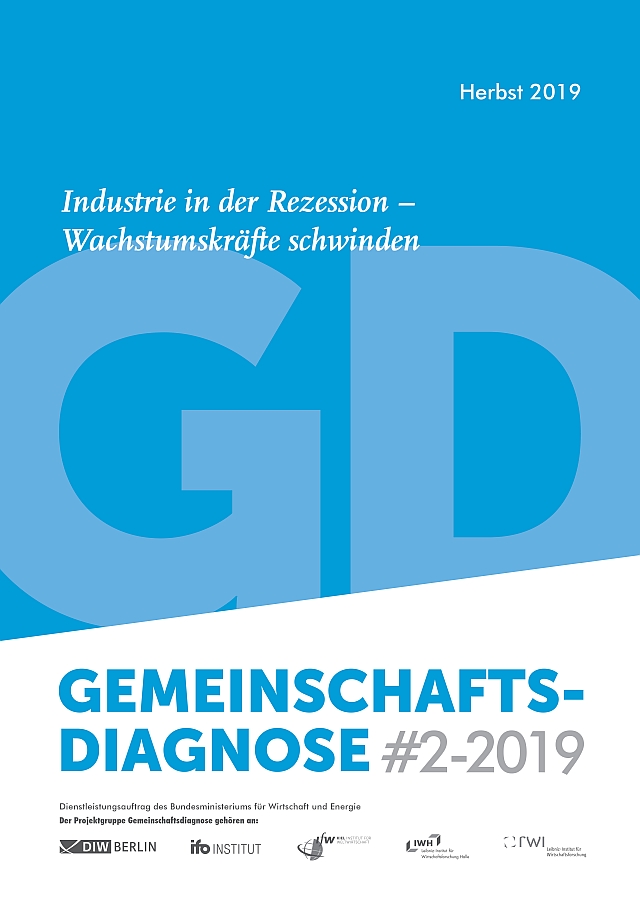Thanks to robust domestic demand, the impact of the manufacturing sector on East Germany is less severe than in the west – Implications of the Autumn 2019 Joint Economic Forecast and official regional data for the eastern German economy
This is shown by monthly data for exports of goods at regional levels and production in East Germany’s manufacturing sector in the first quarter. However, East Germany’s manufacturing sector accounts for only 16% of value added, which is lower than in Germany as a whole (23%), and domestic demand, which is largely directed to services, plays a more important role. This demand is likely to remain robust, partly because disposable incomes in East Germany have recently expanded more strongly than in the west: In 2018, they were 9.8% higher in the east than in 2014, and 7.2% higher in the west. Oliver Holtemöller, head of the Department Macroeconomics and vice president at the Halle Institute for Economic Research (IWH) explains: “One reason for this is that East German labour markets did particularly well recently. In addition, pensions are rising faster in the east than in the west.”
All this explains why economic output in East Germany in the first half of the year expanded more strongly than in the west: According to official data, it was 0.8% higher than in the first half of 2018 in the east, but only 0.4% higher in the west. What made the difference was strong expansion by 1.9% in Berlin, where services dominate the economy. For 2019 as a whole, economic output in eastern Germany is expected to grow by 1%, which is significantly more than in West Germany (0.5%). At 1.3%, growth in 2020 is likely to be only slightly higher than in western Germany. According to the Federal Employment Agency’s definition, the unemployment rate will fall from 6.9% in 2018 to 6.5% in 2019 and 6.3% in 2020.
Whom to contact
For Researchers

Vice President Department Head
If you have any further questions please contact me.
+49 345 7753-800 Request per E-MailFor Journalists

Internal and External Communications
If you have any further questions please contact me.
+49 345 7753-832 Request per E-MailIWH list of experts
The IWH list of experts provides an overview of IWH research topics and the researchers and scientists in these areas. The relevant experts for the topics listed there can be reached for questions as usual through the IWH Press Office.
Related Publications

Industrie in der Rezession – Wachstumskräfte schwinden: Gemeinschaftsdiagnose Herbst 2019
in: Dienstleistungsauftrag des Bundesministeriums für Wirtschaft und Energie, 2, 2019
Abstract
Die Konjunktur in Deutschland hat sich im laufenden Jahr weiter abgekühlt. In beiden Quartalen des Sommerhalbjahrs dürfte die Wirtschaftsleistung geschrumpft sein. Seit Einsetzen des Abschwungs zur Jahreswende 2017/ 2018 ist nunmehr ein Großteil der zuvor recht deutlichen Überauslastung der Produktionskapazitäten abgebaut. Die Gründe für die konjunkturelle Abkühlung sind in erster Linie in der Industrie zu suchen. Dort ist die Produktion seit Mitte letzten Jahres rückläufig, da sich die Nachfrage insbesondere nach Investitionsgütern in wichtigen Absatzmärkten abgeschwächt hat. Allmählich strahlt die Industrierezession auch auf die unternehmensnahen Dienstleister aus. Die Institute erwarten für das Jahr 2019 einen Anstieg des Bruttoinlandsprodukts von 0,5% und damit 0,3 Prozentpunkte weniger als noch im Frühjahr 2019. Für das kommende Jahr wird der Zuwachs ebenfalls schwächer eingeschätzt, nämlich auf 1,1% nach noch 1,8% im Frühjahr. Eine Konjunktur- krise mit einer ausgeprägten Unterauslastung der deutschen Wirtschaft ist somit trotz rückläufiger Wirtschaftsleistung im Sommerhalbjahr 2019 nicht zu erwarten, wenngleich die konjunkturellen Abwärtsrisiken derzeit hoch sind.



